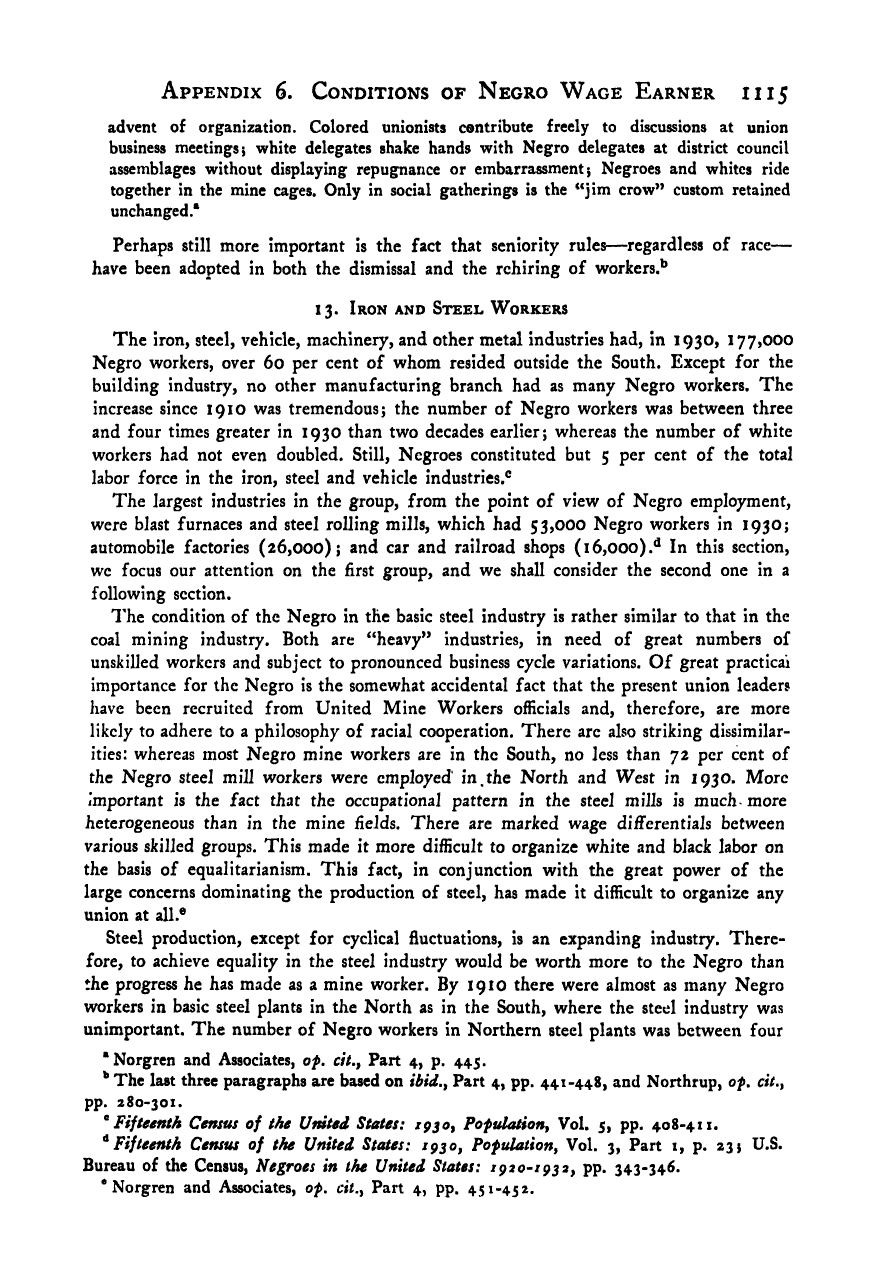Note: Gunnar Myrdal died in 1987, less than 70 years ago. Therefore, this work is protected by copyright, restricting your legal rights to reproduce it. However, you are welcome to view it on screen, as you do now. Read more about copyright.
Full resolution (TIFF) - On this page / på denna sida - Appendices - 6. Pre-War Conditions of the Negro Wage Earner in Selected Industries and Occupations - 12. Coal Miners - 13. Iron and Steel Workers

<< prev. page << föreg. sida << >> nästa sida >> next page >>
Below is the raw OCR text
from the above scanned image.
Do you see an error? Proofread the page now!
Här nedan syns maskintolkade texten från faksimilbilden ovan.
Ser du något fel? Korrekturläs sidan nu!
This page has never been proofread. / Denna sida har aldrig korrekturlästs.
Appendix 6. Conditions of Negro Wage Earner 1115
advent of organization. Colored unionists contribute freely to discussions at union
business meetings; white delegates shake hands with Negro delegates at district council
assemblages without displaying repugnance or embarrassment; Negroes and whites ride
together in the mine cages. Only in social gatherings is the “jim crow” custom retained
unchanged.*
Perhaps still more important Is the fact that seniority rules—regardless of race
—
have been adopted in both the dismissal and the rchiring of workers.**
13. Iron and Steel Workers
The Iron, steel, vehicle, machinery, and other metal industries had, in 1930, 177,000
Negro workers, over 60 per cent of whom resided outside the South. Except for the
building industry, no other manufacturing branch had as many Negro workers. The
increase since 1910 was tremendous; the number of Negro workers was between three
and four times greater in 1930 than two decades earlier; whereas the number of white
workers had not even doubled. Still, Negroes constituted but 5 per cent of the total
labor force in the iron, steel and vehicle industries.®
The largest industries In the group, from the point of view of Negro employment,
were blast furnaces and steel rolling mills, which had 53,000 Negro workers in 1930;
automobile factories (26,000); and car and railroad shops (16,000).** In this section,
we focus our attention on the first group, and we shall consider the second one in a
following section.
The condition of the Negro in the basic steel industry is rather similar to that in the
coal mining industry. Both are “heavy** industries, in need of great numbers of
unskilled workers and subject to pronounced business cycle variations. Of great practical
importance for the Negro is the somewhat accidental fact that the present union leaders
have been recruited from United Mine Workers officials and, therefore, are more
likely to adhere to a philosophy of racial cooperation. There arc also striking dissimilar-
ities: whereas most Negro mine workers are in the South, no less than 72 per cent of
the Negro steel mill workers were employed in. the North and West in 1930. More
important is the fact that the occupational pattern in the steel mills is much - more
heterogeneous than in the mine Helds. There are marked wage differentials between
various skilled groups. This made it more difficult to organize white and black labor on
the basis of equalitarianism. This fact, in conjunction with the great power of the
large concerns dominating the production of steel, has made it difficult to organize any
union at all.®
Steel production, except for cyclical fluctuations, is an expanding industry. There-
fore, to achieve equality in the steel industry would be worth more to the Negro than
the progress he has made as a mine worker. By 1910 there were almost as many Negro
workers in basic steel plants in the North as in the South, where the steel industry was
unimportant. The number of Negro workers in Northern steel plants was between four
“Norgren and Associates, op. ch., Part 4, p. 445.
**
The last three paragraphs are based on ibid.. Part 4, pp. 441-448, and Northrup, of. cit.^
pp. 280-301.
^Fifteenth Census of the United States: 1930^ Pofulationy Vol. 5, pp. 408-411.
^Fifteenth Census of the United States: 1930, Population, Vol. 3, Part i, p. 23; U.S.
Bureau of the Census, Negroes in the United States: 1920-1933, pp. 343-346.
<< prev. page << föreg. sida << >> nästa sida >> next page >>